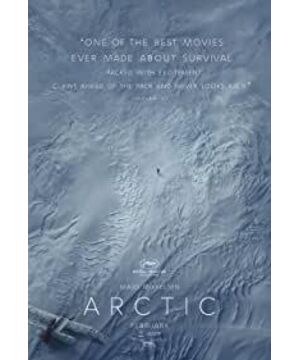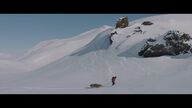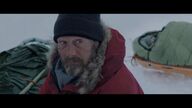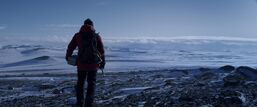Because professional work is related, I have a good understanding of the Arctic region. I started the video with the idea of "following Uncle Mai's learning to survive". It turned out to be disappointing. This is not a film about survival in the wild at all, but a thorough doctrine, or even a religious film .
What the director wants to say is nothing more than Christian clichés, in a word: human beings, as a kind of weak chicken creatures that are too common in nature, rely on their unique spirit of love and sacrifice to obtain fire and gain With warmth, spring is ushered in.
If you know a little bit about survival in the wild and first aid, you will find that the logic in many places in the film feeds the dog. Because the director is not seriously considering survival at all in order to achieve the purpose of preaching. But if it is interpreted from the perspective of a religious film, it is immediately much more reasonable .
Question 1: Where did the hero come from?
The wreckage of the plane at the beginning of the film implies that it seems to be a plane crash. The model of the aircraft is Antonov-An-2, a Soviet aircraft manufactured after World War II. The number on the fuselage is "OK-AGG". It belongs to the Czech Republic and conforms to the former Soviet Union's settings. The painting of the aircraft is "Ayers Polar Cargo Company".
The male protagonist tried to send a distress signal to the hand-cranked radio, which looked like something 50 or 60 years ago. The male protagonist spoke in Danish when he was talking to himself. On the mountainside, he saw that the document in the box he had buried in the past was in English. It said that he was H·Overgård, a typical Danish surname. It is a crew member, and the certificate expires in 2016.
How did the Danish pilots in the 2010s drive old Soviet planes and use radios from World War II? Given the popularity of satellite phones at this stage, let alone pilots, as long as they are people who go to work in the field, they have almost one hand. They are small and easy to use. The coordinates are sent every half an hour, and they can be standby for one month. If they are turned off when not in use, It can stand by for three years . If the male protagonist’s clothes are not torn, the satellite phone will never be damaged. Here I think the director just wants to show that this is a primitive period of " human beings adapt to nature with difficulty without fire ."
Question 2: How can Thais appear in the Arctic?
In the director's setting, the Thais are not here to save people, but to "send fire". With the Thai man sacrificing himself in order to save the hero by forcibly landing, the mankind represented by the hero has obtained the most critical prop, a lighter. Since then, mankind has fired, and civilization has opened a new chapter.
As for why it is Thailand, I think it is purely because Thailand is a Buddhist country. As far as I know, it is impossible to see a Thai scientific expedition team or company in the Arctic. In order to highlight that " another religious civilization from the fringe brought fire ", the director forcibly used the Thai rescue team in the Arctic.
It’s worth mentioning that after the fire, the host used half a jar of gas to cook a meal. He even ate trout ramen hot pot and ate it while turning on the fire. He didn’t know that there was no gas can, and there was no wildness. Common sense of survival, this is also the director's purpose to show that " human beings are squandering extremely limited resources given by God ."
PS Someone asked why the male protagonist was so lucky and happened to crash by the fish pond. In fact, if you have seen a random satellite image of the Arctic region, you will find that it is completely unrealistic to find a good flat land in the North Pole without a fish pond.
Question 3: Why does the male lead hold the female lead freely on the hillside?
The ready-made ice axe and sled are at hand. The hillside is tied to the heroine at one end and the sled at the other end. It uses gravity to pull it bit by bit. Each time it is fixed with an ice axe, it will be pulled up after a while. The experienced pilots of the Polar Cargo Company actually spent a lot of time and physical energy doing meaningless labor here. I think the director is expressing: "Humans under different civilizations need to do many useless work and make many detours in the process of common progress."
Question 4: The heroine miraculously defeated the infection?
You don’t need to have much knowledge of first aid in the field to know that the heroine’s infection is mortal . The hostess once made a rapid breathing sound similar to a whistle. This is actually a sign of difficulty breathing and dying. It is impossible to deal with it urgently. Without eating or drinking, the probability of magically recovering to be conscious and able to speak without antibiotics is so small that it is negligible.
In fact, the real story here is that the male protagonist gave up the female protagonist, left by himself, fell into a crack, and died. The hostess died on the spot and died. Sacrifice + sacrifice, achieve.
From then on, the director's resurrection drama began. The male protagonist crawled out of the cave with his broken leg, and found that outside the cave is the spring of recovery, the female protagonist also miraculously lived, the helicopter also came, the last flare was used, and finally he was rescued.
The most intriguing part of the whole film also came. Seeing the helicopter, the male protagonist dragged his broken leg to climb down the mountain and pushed the female protagonist up the mountain, and then fired the flare for help? This can't be regarded as a metaphor at all, so I almost carried Christ up the mountain and painted my face.
To sum up, the film is a good film, and it does not matter how you understand it.
I just want to provide a new perspective. If you think it is an over-interpretation, please forgive me.
But, don't learn to survive with this film. Eat a small fish sashimi every day, want to dig such a big SOS, before the first S has not turned, you have been frozen to death, exhausted and starved to death.
View more about Arctic reviews









